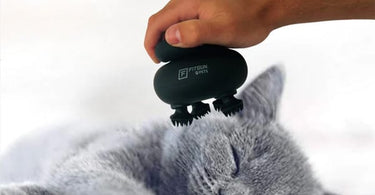Massage is an important part of rehabilitation in veterinary care and is becoming increasingly important, especially for working and sporting dogs.
Massages can strengthen the bond between owner and dog or cat. It also involves physical contact, which is important for both the human and the animal. By getting to know the animal's body, it is easier to recognize changes before they become too widespread.
Effects of massage on your pet:
Contact with the animal reduces stress hormones, which in turn lowers blood pressure, slows the dog or cat's breathing and increases intestinal motility, so that the animal often needs to urinate or defecate immediately after the massage.
A massage can also help release endorphins, which are considered the body's natural painkillers. Many animals enjoy massage, which can help reduce stress, anxiety, and discomfort.
The benefits of horse massage are so varied that it really is a good option for any horse at any stage. In general, there are 5 areas that benefit from massage: muscular, cardiovascular, lymphatic, respiratory and nervous systems.
The first benefit of horse massage is its ability to promote blood circulation. The second most important effect of massage is its ability to influence the nervous system.
Equine massage can be performed for a variety of reasons. Some horses require massage for injuries and rehabilitation, others for arthritis and sore joints, and still others for atrophied or underdeveloped muscles. Some horses that have no specific needs require massage for general, complete relaxation. Horses of all types, breeds, and levels of sport can benefit from massage. Equine massage offers a number of benefits without the need for invasive treatments.
In other words, it is useful for many reasons! Not only does it help the animal relax, as described above, but it also improves blood circulation, which helps to rid the muscles of toxins and lactic acid, reduces the risk of injury by increasing mobility, supports the lymphatic system, and promotes a stronger immune system. This therapy not only pampers your horse, but also promotes the horse's health and performance.
Other effects of massage:
- Blood circulation is increased locally, allowing oxygen and nutrients to be transported more effectively to body tissues.
- Muscles and tendons can gain elasticity through massage, which in combination with stretching can also maintain or improve the range of motion of the joints.
- The muscles often become softer and more relaxed.
- Blood pressure can drop due to the dilation of blood vessels.
- Lymphatic circulation is usually improved.
- The animal can have a more beautiful coat because the metabolism of the skin and sebaceous glands is stimulated.
How often should horses be massaged?
Each horse is different and not all situations are the same; these are two aspects that should be taken into account. When a horse is injured, a schedule can be drawn up with the professional to determine what the animal needs for rehabilitation.
It is usually recommended to have a full body massage or a massage of specific areas every 4-8 weeks, depending on the horse's situation. In between, a more general massage focused on relaxation is usually offered.
How do I know if the horse needs a massage (or is ready for another one)?
"If you listen to the horse, you will hear if he needs a massage. Horses are excellent communicators and have the ability to tell us when and where they are feeling discomfort. If the horse begins to stiffen in the gait, seems uncomfortable under the saddle, or just "not being himself," these are all good signs that the horse is trying to tell you that he is uncomfortable. Before you begin, trust that you know the animal and that he will let you know that he is ready for a massage. In general, owners are advised to give a horse a full massage (or more intensely in a specific area) every 4-6 weeks.
Can you ride the horse after a massage?
It is recommended that after a full or area-specific massage, the horse should not be ridden for at least 24 hours. Instead, a light ride is recommended to stretch your muscles and ligaments. After this time (usually 48 hours), we can resume regular work with the animal. The situation is different if the horse is given a lighter massage for relaxation purposes or in preparation for a competition, because then you can ride it afterwards; this type of massage is often used to promote blood circulation before training.
How long does a massage last?
Each session is tailored to the horse's muscle structure and sensitivity to pressure and touch. In general, a session lasts between one and one and a half hours; however, if more time is needed for certain techniques, this will be scheduled. It is important that the horse feels relieved and relaxed at the end of each session.
The total time the professional spends with the animal and its owner is about two hours, as this is usually preceded by an exchange of information in which the owner provides information about the horse's condition and medical history.
When is a massage useful?
- For muscle tension.
- For stiffness and pain.
- In case of poor blood circulation and resulting swelling.
- To warm up before stretching.
- To combat stress.
- For scars.
- For stiffness and limited mobility.
- For joint pain.
- To improve the relationship between owner and dog.
- If the dog or cat has osteoarthritis.
When should a massage be avoided?
- In case of fever, infections or inflammations.
- If the animal has wounds and/or bleeding.
- For eczema and other skin conditions with dry or damaged skin.
- In case of pregnancy.
- In case of acute injuries to the muscles or skeleton.
- In case of abnormal pain of the dog or cat (without consulting a veterinarian).
- In case of general deterioration of health.
- In case of tumor diseases (without consulting a veterinarian).

